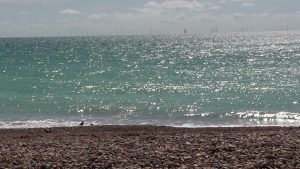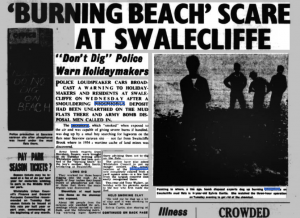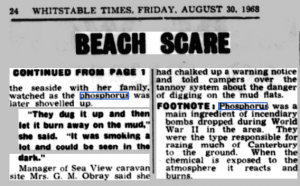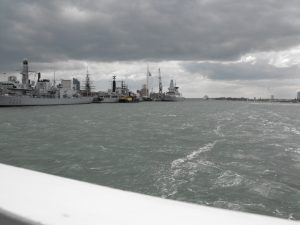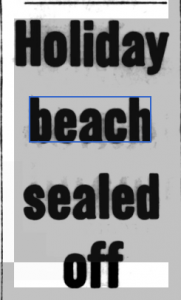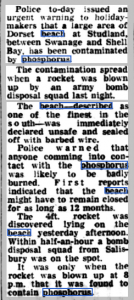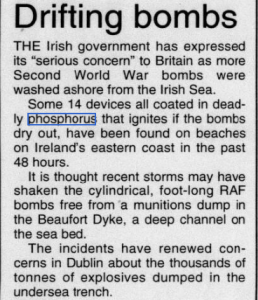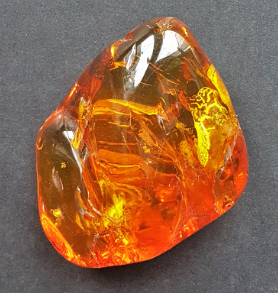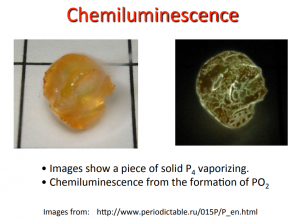It seems the berks in the Home Guard were not the only fools to dispose of P4 WMD, but whereas land was their preferred method, the regulars were at it using watery graves.
A great piece from Chemistry World raises the issue of former white phosphorus weapons that have been ludicrously dumped at sea finding their way back to land and the issues this causes when beachcombers may pick up fragments of still dangerous armaments.
It states
“In 1995 more than 4500 incendiary bombs – made of phosphorus, benzene and cellulose – washed up on beaches around Scotland’s west coast. They were part of an estimated million tons of munitions dumped between 1945 and 1976 by the Ministry of Defence in Beaufort’s Dyke, an underwater trench between Northern Ireland and Scotland. It was speculated that the munitions were disturbed by work on an undersea gas link between the two countries.”
I have found a few more incidents similar to this which reveal the British Government’s insane legacy of post war fly-tipping.
The 30th August 1968 Whitstable Times and Herne Bay Herald reported how a young boy had been digging near to a caravan site in Swalecliffe when the mud started to smoke.
One may speculate if the “enemy” had dropped a bomb in the area, or if this was another Gov dumping event gone wrong.
It appears that there was not much of a plan, other than to rake the area and let it burn out.
Just a couple of years later, the Herne Bay Press of 24th July 1970 revealed that more p4 had washed ashore “probably from a submerged wreck in The Thames Estuary”. I have no doubt that this was from the notorious SS Richard Montgomery, which the UK Government have been shitting themselves for years as to what to do with it, but I don’t think that these off floaters from the wreck , or the potential for such events have been publicised in recent times. So they continue to leave it where it lies.
Two Liverpool Echo reports perhaps show the waste of taxpayers money spent on supposedly training soldiers who appear to be thicker than dogshit for blowing up bombs on the beaches. This hazard was created by them and their utter incompetence which meant that fragments of the solid had scattered over a wider area putting the public at more risk than the actual bomb itself.
The first of 5th August 1969 concerns how the morons blew up a rocket on a Dorset beach , which would require 5 tonnes of contaminated sand to be removed. How is it possible that these “experts” were not able to identify that the device contained p4?
On 6th June 1972 , we appear to get a repeat exercise taking place.
A couple of more recent incidents in the UK can be found in internet searches.
This article from 2015 shows just how dangerous white phosphorus is when it comes into contact with flesh. “Not a chemical weapon”- my fat hairy arse!
Newcastle man found ‘Orange stone’ on beach and it set his leg on fire | Daily Mail Online
Just last year the Navy EOD destroyed a phosphorus flare
And it isn’t just in the UK that Britain’s wartime legacy rears its ugly head. The Beaufort’s Dyke graveyard continues to drift unwanted munitions debris towards Irish beaches as the Hartland Evening News of 5th June 1998 showed.
And in Germany, the legacy of the RAF firestorm still persists in tiny pockets of “amber” like rocks burning civilians.
Two Women Injured After Touching WWII Phosphorus on German Beach – DER SPIEGEL
Woman mistakes WWII white phosphorous for an amber stone | Daily Mail Online
I suppose it goes to show that “war criminals” are only those who lose wars I suppose. 😥
A warning from an Israeli case also shows the dangers of taking such artefacts home and discusses the medical implications of treating injuries.
The burning issue of white phosphorus: a case report and review of the literature – PMC (nih.gov)
So the next time you head for the coast and pick up something orange and unusual on the beach, forget Jurassic park , just don’t put it in your pocket, or you might find your behind getting very warm, and that will just be the least of your worries…..

